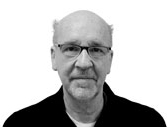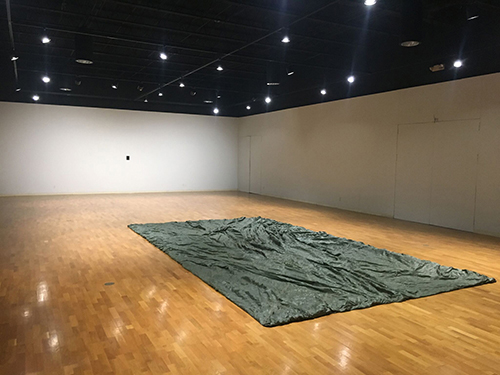
PAUL KRAINAK
Before Bill Conger became curator of exhibitions and collections at the Peoria Riverfront Museum, his critical capability was honed at the University Galleries at Illinois State University. He worked with Barry Blinderman for more than a decade, a highly productive and exciting period for the galleries and the department of art. Blinderman readily recounts Conger’s contribution to the gallery. “I had the pleasure of collaborating with Bill for 10 years, looking at, talking about and making books about art with impunity. The exhibitions he curated over that period followed no trend, deriving their themes and titles from literary sources as disparate as Virginia Woolf and Bernie Taupin –– enigmatic names like Otherville, pixerina witcherina, or New Angeles, which in 2001 included a painting by Dana Schutz before anybody had heard of her.”
Bill’s curatorial expertise is informed by his artwork and ideas that intersect studio practice, poetry, design and architecture. Barry continues, “Bill Conger has a poet’s eye. Whether curating, artmaking or writing, he captures the essence of his quarry, finding connections between things that few others would notice, remarking for instance on a sculpture’s “not-quite-royal, not-quite-Yves Klein blue. He’s also refreshingly free of ego, allowing him to work unfettered in an increasingly zero-sum art world.”
Conger and Blinderman co-curated memorable shows such as “The UFO Show”, “Growing Up Postmodern”, “Tony Tasset: Better Me”, and “Jim Lutes”. They co-designed books for each show, including the engrossing and popular “Post-hypnotic” that included contemporary painters who engaged strategies of Op-art into their work. It included large scale work from Ross Bleckner, Sarah Morris, Philip Taffe, Karin Davie, etc.. The redoubtable critic Dave Hickey was interviewed by Barry for its publication and the show traveled throughout the country.

“The Last Blue,” 2018, Collage on lucite, 36 inches by 30 inches (PHOTO BY BILL CONGER)
After a brief hiatus from curating, Bill is pleased to be plying his intellectually diverse art perspective and competencies at the “Riverfront.” He’s pursuing new research opportunities in and is committed to an intricate fusion of contemporary and historical themes to suit the needs of Peoria’s varied demographics. The Riverfront’s president John Morris is enthusiastic about the cultivation of a new art identity in Illinois under Conger’s guidance.
While Bill Conger’s educational position requires attention to a diverse art playing field, his own artwork rests on a radical platform of ambient signs and poetic enigmas –– ones that stand in opposition to formal hierarchies or values from either the artworld or popular culture. He channels a bit of youthful dissonance with a virtuous mystification of ordinariness. His texts, performative installations and collages acknowledge the reductivist narrative that signaled the first real crisis in criticism in mid 20th century art. He reconciles this sense of absence and chaos by also reminding us of the West’s fidelity to art as auratic and transformative, embodied in discreet signs and subtle, contemplative experiences.
Conger’s projects recall the 1960’s Art Povera movement where minimalist strategies were critiqued with a deference toward inexpensive, rudimentary materials. Like Congers work, Art Povera was sensitive to time and place and disposed to assemblages and text. They challenged reductivism by asserting fragments of myth and connecting art to ordinary life and ordinary life with history. They traded in sometimes absurd, anti-institutional ephemerality, exploring non-linear paths between nature, industry and psychology.
Conger’s work is a slight fetishization of subversion and eroticism, (surrealism with a small “s”). He puns on the way high culture obsesses about private and public, and resists all the vexing art terminology that submerges knowledge in style. Collage is the key to his practice. They aren’t centered on contrasting images nor the color or patterns that appear from the breakage of the plane. It’s the breach as a thing –– the tear on the surface, the violation of the sign. His objects then become a further disturbance and aestheticization of that logic, only inverted, fleshy and ritualistic.
Bill Conger opens a solo exhibition at Goldfinch Gallery in Chicago on Sunday Nov. 4.

1 comment for “Inland Art | A poet’s eye”
Recent Comments
That’s my son. I am so proud of him.